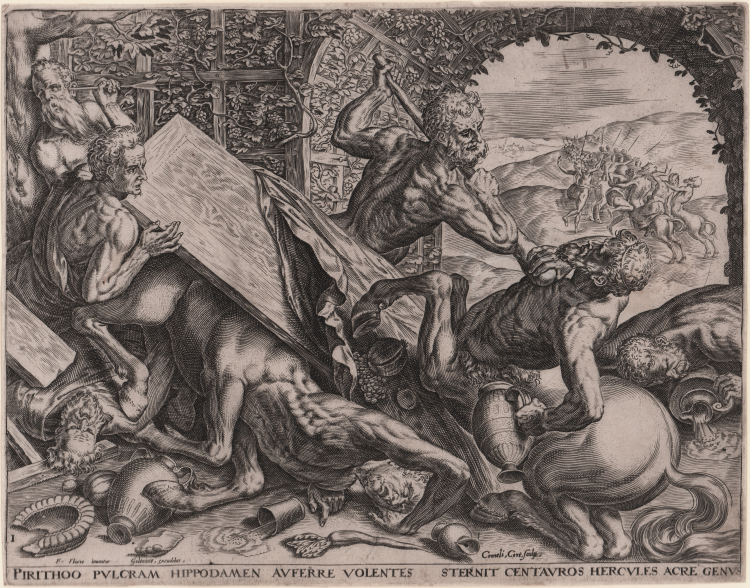




| Reference: | S30319 |
| Author | Cornelis CORT |
| Year: | 1565 |
| Measures: | 290 x 230 mm |



| Reference: | S30319 |
| Author | Cornelis CORT |
| Year: | 1565 |
| Measures: | 290 x 230 mm |
Engraving, 1565, signed on plate with the names of the engraver and the editor. After a painting by Franz Floris. From the series The Twelve Labours of Hercules. Example in the IV state of IV, according to Sellink – Leeflang.
Excellent work, printed on contemporary laid paper, trimmed on the marginal line, in good condition.
The Twelve Labours of Hercules in a suite of 10 engravings, edited for the first time in 1565 by the Antwerp publisher Hieronymus Cock who also published the second and the third edition. The last edition was edited by Justus Goltzius.
The engravings reproduce the cycle of paintings made around 1555 by Frans Floris for the residence of the Antwerp merchant Nicolaas Jonghelinck; only one of these paintings has survived. The drawings Cort used as models were probably done by Simon Jansz. Kies, one of Floris’ pupils. The limited amount of space available in the room where the paintings were displayed obliged Floris to compress the twelve works into ten painted compositions, two thematically related episodes being combined on two of the paintings. Cornelis Cort also adopted this procedure but extended Frans Floris’ compositions to include a landscape backdrop.
Cort’s engravings stand out for their concentrated, powerful technique and compositional coherence. The somewhat dry, unpolished linework gives the prints great expressive power which dramatically brings out the dynamism and the raw violence of the individual episodes. Cort’s disciplined burin technique with its dense hatching patterns gives both man and beast an almost sculptural plasticity and a tremendous physical presence, while the striking chiaroscuro effectively intensifies the pathos of the individual scenes.
The subject is rather strange because according to Ovid is not Hercules but Theseus to hunt the centaurs that were invited to the wedding feast of Piritto and Hippodamia, they begin to behave wildly until one of them, Eurytus, assails the bride unleashing a furious battle. This episode is not even mentioned among those legendary labors of Hercules.
Ex collection Leroy Kirwin 'Roy' Burket (Lugt 3389).
|
Sellink M./ Leeflang H., 2000, v. III p. 32 n. 173; The New Hollstein 172–181
|
Cornelis CORT (Hoorn, nr Alkmaar, 1533 - Roma, prima del 22 Aprile 1578)
|
North Netherlandish engraver and draughtsman, active in Flanders and Italy. His first documented works are a series of engravings issued by the Antwerp publisher Hieronymous Cock, beginning c. 1553. Cort may have been an apprentice within Cock’s establishment, as none of these prints was inscribed with his name until after the plates had passed out of Cock’s hands. A letter of 1567 to Titian from the Netherlandish writer and painter Domenicus Lampsonius (1532–99) describes Cock as Cort’s master. By 1560 Cort had developed a bold and strongly modelled sculptural style of engraving, influenced in part by the Italian Giorgio Ghisi, who worked for Cock between 1550 and 1555. Cort was particularly successful in reproducing the Italianate figure compositions of Frans Floris, after whom he engraved more than 50 prints, notably the Liberal Arts (seven prints; 1565) and the Labours of Hercules (ten prints; 1565). He also reproduced compositions by Maarten van Heemskerck, Andrea del Sarto, Rogier van der Weyden and others while working for Cock.
|
|
Sellink M./ Leeflang H., 2000, v. III p. 32 n. 173; The New Hollstein 172–181
|
Cornelis CORT (Hoorn, nr Alkmaar, 1533 - Roma, prima del 22 Aprile 1578)
|
North Netherlandish engraver and draughtsman, active in Flanders and Italy. His first documented works are a series of engravings issued by the Antwerp publisher Hieronymous Cock, beginning c. 1553. Cort may have been an apprentice within Cock’s establishment, as none of these prints was inscribed with his name until after the plates had passed out of Cock’s hands. A letter of 1567 to Titian from the Netherlandish writer and painter Domenicus Lampsonius (1532–99) describes Cock as Cort’s master. By 1560 Cort had developed a bold and strongly modelled sculptural style of engraving, influenced in part by the Italian Giorgio Ghisi, who worked for Cock between 1550 and 1555. Cort was particularly successful in reproducing the Italianate figure compositions of Frans Floris, after whom he engraved more than 50 prints, notably the Liberal Arts (seven prints; 1565) and the Labours of Hercules (ten prints; 1565). He also reproduced compositions by Maarten van Heemskerck, Andrea del Sarto, Rogier van der Weyden and others while working for Cock.
|